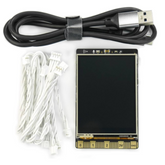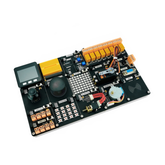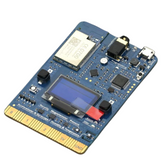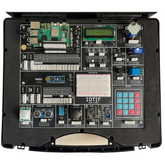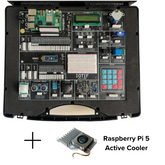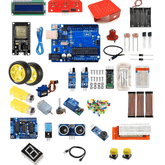Security Risks of IoT Devices
Summary
Unlocking the potential of the Internet of Things (IoT) comes with its own set of challenges, particularly in the realm of security. In our latest blog, we delve deep into the world of IoT, exploring its definition, characteristics, and the critical issue of IoT security. From top 10 security risks to real-life cyber attack examples, we uncover the potential threats facing IoT devices and their impact on users. But fear not! We also provide 7 essential best practices to fortify your IoT systems. Join us as we dissect which industries are most vulnerable to IoT security threats, offering insights to safeguard your digital domain. Dive into our comprehensive guide and empower yourself against the evolving landscape of IoT security risks.
What is IoT
The term "Internet of Things" (IoT) describes a group of technologies that use sensors and actuators to deliver real-time data on different entities and things in our surroundings. These things might be anything from living things to commonplace things like cars and tools. These items can communicate and interact with cloud-based systems and with one another thanks to the Internet of Things.

The data acquired by sensors and actuators is received and processed by these cloud platforms, which then analyzed to extract insights and make defensible decisions. IoT essentially makes it easier for physical devices to be seamlessly integrated into the digital realm, which enables improved process and environment monitoring, control, and optimization.
What are the Characteristics of IoT
The Internet of Things (IoT) is a modern technology platform that is supported by a number of identifying characteristics. At its core, IoT involves network connectivity, allowing devices to communicate with each other and centralized systems, assisted by technologies like Wi-Fi, Bluetooth, or cellular connections. IoT devices, which have been equipped with sensors, software, and electronics, gather and share data constantly, creating an interactive ecosystem that allows the devices to react to changes in their environment.
The development of intelligent systems and services, which promote automation, monitoring, and optimization across numerous fields, is based on this data exchange. The Internet of Things (IoT) is important because it builds a bridge between the physical and digital worlds, making it simple to incorporate real-world objects into digital ecosystems to enable new uses and solutions.
IoT promises to revolutionize both daily life and industry because of its scalability to meet changing needs and wide range of devices, from industrial equipment to domestic devices.
What is IoT Security
IoT security, or Internet of Things security, is a crucial component of modern technological ecosystems. Protected by a comprehensive set of standards and processes, the Internet of Things is an extensive network of linked machines, devices, and systems.

It becomes more important to keep devices and data secure as more and more devices join the Internet of Things (IoT). Devices having internet connections are vulnerable to hackers who may use them to obtain illegal access, alter data, or carry out cyberattacks. Effective IoT security procedures are important because of things like the wide range of IoT device sources, how they handle sensitive data, and the possible effects of security breaches on organizations.
IoT security uses a variety of techniques and tools, such as device management, encryption, authentication, standardization, and security awareness programs, to overcome these obstacles. Through the implementation of these measures, companies may preserve the availability, integrity, and confidentiality of IoT systems and data, as well as limit the risks associated with IoT deployment. This will allow for the ongoing innovation and growth of linked technologies.
Top 10 Security Risks of IoT Devices
Multiple interconnected devices:
There are significant security vulnerabilities associated with the proliferation of linked devices.
A single point of failure might result from a compromise in one device, which exposes vulnerabilities throughout the network. The attack surface is increased by this interconnection, giving hackers more points of access to take advantage of.

It becomes difficult to manage security across several devices, necessitating ongoing attention and updates. Data privacy issues can arise because connected devices might exchange private data.
In order to reduce these risks and safeguard IoT environments from potential attacks, it is essential to implement strong security mechanisms including network segmentation, strong authentication, and encryption.
Weak security:
One major security risk associated with IoT devices is weak login password. Devices that use default or simple to guess passwords and insufficient authentication methods are open to unauthorized access.

This weakness is not limited to specific devices, it has the ability to corrupt entire networks and enable a variety of illegal activities, such as engagement in malware networks and data leaks.
To reduce this risk and improve the general security of IoT ecosystems, strengthening authentication mechanisms with the use of strong passwords, multi-step verification, and strong user authentication protocols is crucial.
Insecure ecosystem interfaces:
Insecure ecosystem interfaces in IoT present serious security risks. Issues in the cloud, mobile interfaces, backend API, or online can result in compromises, giving hackers the opportunity to take advantage of holes in security and access the entire Internet of Things network without authorization.

Weak encryption, inadequate input/output filtering, and inadequate authentication/authorization are common problems that give hackers access points to breach the system.
Ensuring data integrity and confidentiality and protecting IoT ecosystems from potential intrusions require the implementation of strong authentication and authorization methods, robust encryption protocols, and extensive input/output filtering.
Absent firmware updates:
The absence of timely firmware updates represents a critical security risk in IoT environments. In the absence of routine updates, devices can continue to be exposed to known hacks and vulnerabilities, which could result in data breaches, device compromise, or illegal access.

Although it is preferred to update firmware remotely, there are situations where physical access to updates is necessary due to practical issues such as poor network speed or restricted messaging capabilities.
Managing security risks and preserving the integrity and security of IoT devices and ecosystems requires ensuring a streamlined firmware update and implementation procedure.
Use of old or vulnerable components:
There is a serious security risk when using outdated or insecure components in Internet of Things devices. This includes third-party components from hacked supply chains, outdated software libraries, and unsafe operating system customizations.

These parts might have existing vulnerabilities that hackers could use to compromise the device or the Internet of Things as a whole. The supply chain is made more difficult to detect and prevent possible risks by the usage of open-source components.
Manufacturers need to put a high priority on using secure components, perform frequent security audits, and put strong patch management processes in place in order to reduce vulnerabilities and protect IoT deployments from any attacks.
Insecure transfer of data and storage:
Insecure data transfer and storage represent critical vulnerabilities in IoT systems. Sensitive information is vulnerable to illegal access, interception, and manipulation if it is not secured while it is in use, in transit, or during processing.

Data breaches, invasions of privacy, and impaired system integrity may result from this. Strong encryption methods, access restrictions, and safe data transfer techniques must be put in place in order to reduce these dangers and guarantee the privacy, availability, and integrity of IoT data.
To enhance the overall IoT security posture, frequent security audits and adherence to industry standards can assist in locating and addressing possible weaknesses in data handling procedures.
Legacy assets:
Because of their outdated architecture and incompatibility with current security requirements, legacy assets present serious security risks in Internet of Things systems.
These resources could be open to cyberattacks since they don't support the most recent encryption techniques or security features. Without sufficient security safeguards, upgrading legacy systems for cloud connectivity might leave them vulnerable to new risks like data breaches or unauthorized access.

Also, it could be challenging to successfully apply security upgrades or fixes due to the complexity of legacy systems. Organizations need to prioritize security evaluations in order to manage these threats, and they should also think about replacing or updating legacy assets with more secure options.
IoT settings can be shielded from potential security breaches and vulnerabilities by putting strong security controls and monitoring methods in place.
Remote access:
Because IoT devices are internet-connected, remote access presents a serious security concern. Because of their accessibility, devices can be remotely accessed by hackers and are therefore vulnerable to scams like phishing, malware infections, and unauthorized access, among other intrusions.
Because remote connectivity creates a larger attack surface, there is a higher chance that it may be exploited, which could result in device compromise, service interruptions, or data breaches.

Organizations must put strong authentication procedures, encryption techniques, and access controls in place to safeguard remote access to IoT networks and devices in order to reduce this risk.
In order to identify and proactively resolve vulnerabilities and ensure the integrity and confidentiality of IoT systems in remote contexts, regular security evaluations and updates are also necessary.
Absence of physical protection:
IoT devices that lack physical protection run a serious security risk since it gives possible attackers access to private data and/or local device control. In the absence of sufficient physical security measures, hackers could tamper with devices, alter their operations, or steal important data.

When IoT devices are placed in dispersed and distant contexts, this vulnerability becomes especially concerning. Ensuring the security and dependability of IoT deployments requires protecting the hardware from unauthorized manipulation, tampering, and physical access.
IoT devices can be shielded from unwanted interference and the possibility of physical attacks by putting in place safeguards like physical access controls, secure enclosures, and tamper-evident seals.
Insecure default configurations:
Insecure default settings in IoT devices represent a critical security vulnerability. Hackers may target devices that come with default settings that are weak or simple to break in order to obtain unauthorized access or threaten the security of the device.

Hardcoded default passwords, covert backdoors, and constrained user setup options are common problems. Once these settings have been broken, attackers may take advantage of firmware flaws in the device, which could result in the manipulation of the device, illegal data access, or involvement in botnet operations.
Manufacturers must create secure default settings, allow users the ability to adjust setups, and inform users about the significance of changing default passwords and safeguarding their devices in order to mitigate this risk.
How do IoT Device Security Risks Affect Users?

- Afterward Movement: Hackers may access networks, gain more privileges, and spread malware by taking advantage of IoT vulnerabilities.
- Botnets: It can be difficult to prevent DDoS attacks because infected IoT devices are used in building botnets for such attacks.
- Security Problems: Sensitive data gets compromised and data breaches are caused by weak security in IoT devices.
- Residential Risks: Personal and business data are at risk due to vulnerable residential IoT devices that act as entry points to networks.
- Data breaches: By taking advantage of holes in IoT devices, someone could get unauthorized access to private information, violating privacy rights and causing financial losses.
- Physical Safety Risks: If hacked by dangerous individuals, compromised Internet of Things devices—like smart home appliances or medical equipment—may put users' physical safety at risk.
Top 5 Real-Life Cyber Attacks Example by IoT Security Vulnerabilities:

Mirai Botnet and DDoS attacks (2016):
The Mirai botnet organized massive Distributed Denial of Service (DDoS) assaults by taking advantage of weakly secured Internet of Things devices. Hackers conducted some of the biggest DDoS attacks by hacking weak devices like routers and cameras, disrupting popular online platforms and highlighting the pervasive effects of inadequate IoT security.
The Verkada:
The cloud-based video surveillance provider Verkada had a cyberattack in March 2021. Using authentic admin account credentials that could be available online, the attackers were able to access the private data of Verkada software clients as well as live feeds from over 150,000 cameras installed in factories, hospitals, schools, jails, and other locations. It was eventually discovered that more than 100 workers had "super admin" access, giving them access to thousands of customer cameras. This highlighted the dangers of having too many privileged users.
Smart Home Invasion:
Hackers obtain illegal entry to people's homes by taking use of weaknesses in smart home appliances like door locks, thermostats, and webcams. This compromises privacy and raises serious concerns about IoT-enabled living environments.
Stuxnet (2010):
This cyberattack targeted a uranium enrichment plant in Natanz, Iran. It gained access to industrial program logic controllers by infiltrating Siemens Step7 software, which was operating on Windows. This made it possible for developers to obtain crucial industrial data and operate machinery at industrial sites. It is anticipated that 984 uranium-enrichment centrifuges were damaged by Stuxnet, which led to a 30% decrease in processing efficiency.
The Jeep Hack (2015):
This attack, which was showcased by an IBM team in July 2015, gained access to a Jeep SUV's onboard software by taking advantage of a security hole in the firmware update mechanism. The car was completely controlled by the researchers, who changed the steering and speed, leading the vehicle to turn off the road. Ensuring the security of vehicles is becoming more and more important as more adopt IoT technologies, particularly with the rise of electric and autonomous vehicles.
7 best practices to protect IoT systems and devices

Use network segmentation:
To manage the flow of traffic between devices, divide your network into separate pieces. Create distinct segments for IoT devices and IT assets using next-generation firewall policies and virtual local area network (VLAN) settings. This improves overall network security by reducing the possibility of lateral movement in the event of an unauthorized event.
Secure Passwords and Authentication:
Make sure every Internet of Things device has a strong, unique password. Instead of using the default credentials, use complicated passwords. To add a higher level of protection, use multi-factor authentication (MFA) when it is possible. To stop unwanted access, never reply to MFA requests that you did not initiate.
Regular Firmware upgrades and Patch Management:
Make sure you're keeping an eye out for IoT device firmware upgrades and patches. Establish a regular patch management plan in close collaboration with vendors. Frequent updates ensure that devices have the newest security upgrades installed and help mitigate known vulnerabilities, lowering the chance of attack.
Take Out Any Unused IoT Devices:
Remove any IoT devices from your network that aren't being maintained or used regularly. Since unused devices are frequently ignored and left unpatched, they could present security issues. By removing them, you can improve the overall security of your network by decreasing the number of possible attack routes.
Efficient Device Inventory Management:
Ensure that every connected Internet of Things device in your network is accurately inventoried. To keep ahead of potential threats, use automated systems for inventory management and device detection. Being aware of every device that is linked enables you to swiftly spot any unauthorized or suspect behavior and implement the proper security measures.
Continuous Monitoring and Threat Detection:
Network traffic should be regularly monitored in order to spot any unusual activity or potential security risks. To do this, put in place a thorough monitoring system. To quickly detect and address security breaches, make use of intrusion prevention systems (IPS) and intrusion detection systems (IDS). To proactively find and fix security flaws before they may be exploited, regularly analyze logs and carry out security audits.
Use Public Key Infrastructure (PKI) and Digital Certificates:
PKI is a technique that is used to protect client-server communications between networked devices. PKI uses digital certificates to encrypt and decrypt private messages using a two-key asymmetric cryptosystem, ensuring safe communication. PKI implementation improves IoT system security and safeguards private data transferred between devices.
Which industries most face IoT security threats?
The following sectors are particularly affected by IoT security risks:
- Vital Infrastructure and Healthcare Utilities
- Banking and Related Services
- Governmental Organizations
- Transportation and Manufacturing
- Smart Cities
- Logistics Supply Chain Communications
- Education
Conclusion:
The broad use of Internet of Things (IoT) devices offers a wide range of advantages for convenience, efficiency, and innovation in several fields. However, with these benefits come major dangers that must be addressed to safeguard sensitive data, protect privacy, and ensure the security of systems. A variety of issues are related to IoT security, such as old components, unsecured interfaces, weak passwords, and insufficient firmware updates.
These flaws make it possible for cybercriminals to gain access to whole networks and expose individual devices to exploitation, which could result in data breaches, interruptions to services, and even risks to physical safety. The necessity of fixing IoT security flaws is highlighted by real-world intrusions like the Jeep hack, the Verkada leak, and the Mirai Botnet DDoS attacks.
These incidents highlight the far-reaching consequences of inadequate security measures and serve as cautionary tales for individuals and organizations alike. To mitigate IoT security risks, it is essential to implement best practices such as network segmentation, strong authentication mechanisms, regular firmware updates, and continuous monitoring for threat detection.
Additionally, industries across various sectors, including vital infrastructure, healthcare, banking, government, transportation, manufacturing, and smart cities, must prioritize IoT security to protect critical assets and infrastructure.



